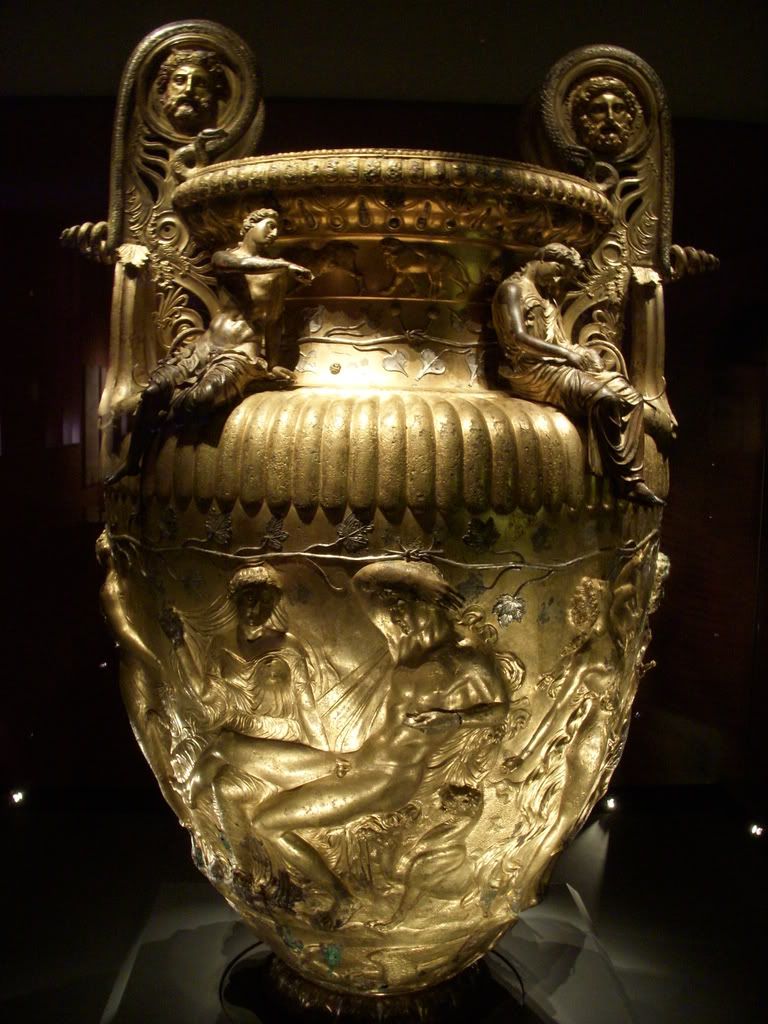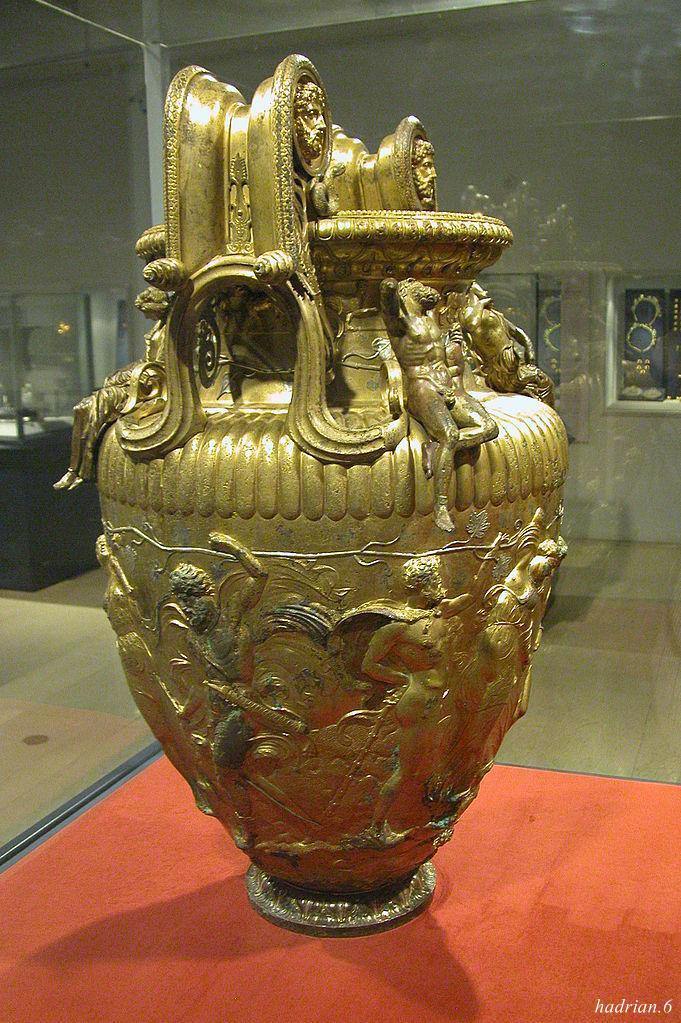The Derveni krater is a volute krater,the most elaborate of its type, discovered in 1962 in a tomb at Derveni, not far from Thessaloniki, and displayed at the Archaeological Museum of Thessaloniki. Weighing 40 kg, it is made of an alloy of bronze and tin in skillfully chosen amounts, which endows it with a superb golden sheen without use of any gold at all.
Discovery
The krater was discovered buried, as a funerary urn for a Thessalian aristocrat whose name is engraved on the vase: Astiouneios, son of Anaxagoras, from Larissa. Kraters (mixing bowls) were vessels used for mixing undiluted wine with water and probably various spices as well, the drink then being ladled out to fellow banqueters at ritual or festive celebrations. When excavated, the Derveni krater contained 1968.31 g of burnt bones that belonged to a man aged 35–50 and to a younger woman.
Technique and decoration
The vase is composed of two leaves of metal which were hammered then joined, although the handles and the volutes (scrolls) were cast and attached. The top part of the krater is decorated with motifs both ornamental (gadroons, palm leaves, acanthus, garlands) and figurative: the top of the neck presents a frieze of animals and most of all, four statuettes ( two maenads, Dionysus and a sleeping satyre) are casually seated on the shoulders of the vase, in a pose foreshadowing that of the Barberini Faun. On the belly, the frieze in low relief, 32.6 cm tall, is devoted to the divinities Ariadne and Dionysus, surrounded by revelling satyrs and maenads of the Bacchic thiasos, or ecstatic retinue. There is also a warrior wearing only one sandal, whose identity is disputed: Pentheus, Lycurgus of Thrace, or perhaps the "one-sandalled" Jason of Argonaut fame.
Dating
The exact date and place of making are disputed. Based on the dialectal forms used in the inscription, some commentators think it was fabricated in Thessaly at the time of the revolt of the Aleuadae, around 350 BC. Others date it between 330 and 320 BC and credit it to bronzesmiths of the royal court of Philip II of Macedon.
Inscription
The funerary inscription on the krater reads:
ΑΣΤΙΟΥΝΕΙΟΣ ΑΝΑΞΑΓΟΡΑΙΟΙ ΕΣ ΛΑΡΙΣΑΣ
The inscription is in the Thessalian variant of the Aeolian dialect: Ἀστιούνειος Ἀναξαγοραίοι ἐς Λαρίσας (Astioúneios Anaxagoraīoi es Larísas), "Astiouneios, son of Anaxagoras, from Larisa. If transcribed in Attic, the inscription would read: Ἀστίων Ἀναξαγόρου ἐκ Λαρίσης (Astíōn Anaxagórou ek Larísēs).



The krater stands 91 centimetres tall and weighs approximately 40 kilograms. Due to a high concentration of tin in the bronze used for its creation, the vessel appears as if it is made of gold. The ivy leaf and berry garland motif on the neck, the Greek inscription on the rim, as well as the vine wreath decoration above the principal figure scene, were added in silver. Though used solely to hold the ashes of the deceased man and woman, the mouth of the krater was fitted with a strainer to prevent sediment from collecting and/or entering into the vessel during the mixing of wine and water.
The body of the vessel is decorated with a figural scene achieved using the repoussé technique by which the artist hammers through from the back to create a relief on the front. Here, Dionysos, seated next to Ariadne, is surrounded by numerous satyrs and maenads. Repetitive animal friezes run both below the rim of the vessel and the main figural scene. The volute handles are adorned with the images of four bearded men, none of which are identified as being related to any specific character, mythical or otherwise. Between the rim and body of the krater are four figures; Dionysos, two maenads, and a satyr. These sculpted additions recline on the shoulder of the krater at each side of each handle.



Δεν υπάρχουν σχόλια:
Δημοσίευση σχολίου